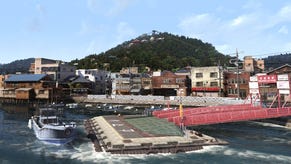Yakuza 3
Way of the dragon.
Yakuza 3 is the truest representation of modern Japan in videogames. Not in the overwrought melodrama of the story, which largely barrels by in a blur of crying orphans and angry men shouting at one another before taking their tops off and smacking each other around, but in the incidental detail: the vending machines, arcades, bars, the incessant welcoming calls of 'irassyaimasseeeee!' from shop staff, and the Okinawan side streets housing mysterious buildings of inscrutable function.
And like modern Japan, Yakuza 3 feels like a jarring contradiction of stubborn traditionalism and sleek modernity. It is a beautiful game lavished with attention to detail, the production values and budget are sky-high, and the quality and authenticity of the acting and plot (if you can forgive the aforementioned melodrama) is far, far ahead of others in the genre. But underneath it all is a game that's barely changed since the original Ryu ga Gotoku in 2005.
At heart it's an old-fashioned action-RPG, often linear and uninventive in terms of gameplay, sending you wandering around its massive world searching for some arbitrary trigger to advance the story with depressing regularity. The combat veers wildly between violent, undemanding fun and fist-eating frustration. Just like its predecessors, though, Yakuza 3 charms you into forgiving it for being so set in its occasionally awkward ways. It's so amazingly well-crafted, and though nothing it does is particularly original, it's unique in the way it brings JRPG, 3D brawler and a host of disparate mini-games together into a cohesive whole.
There is at least a significant change of scenery. It turns out that former-gangster-gone-good Kiryuu left Tokyo after the events of Yakuza 2 in order to set up an orphanage in tropical Okinawa, the southernmost island chain of Japan. For the first several hours of the game it seems that Kiryuu is putting his weapons skills and intensely serious expression to use by chopping onions for dinner and resolving playground disputes instead of negotiating with gangsters and introducing bad men's faces to solid walls, but of course it doesn't last forever.
Soon, the land that Kiryuu's orphanage is built on is threatened by a shady political deal involving building a giant resort on it instead, and Kiryuu is compelled to investigate. It all turns out to be part of a massive gang conflict, and he ends up going back to Tokyo to try and resolve it. It's worth pointing out at this point that following Yakuza 3's story is fairly challenging even if you do have a handle on what went on in the previous two games - by now, the series' complicated web of characters and plot history is flummoxing - but it doesn't matter particularly. The stylish, well-shot cut-scenes are entertaining to watch even if the majority of the exposition goes over your head.
The combat, too, is excellent fun to watch - considerably more than it is to play, unfortunately, but it has a certain old-school charm. The combat is more weapons-centric that Yakuza 2's, more along the lines of series spin-off Ryu ga Gotoku Kenzan. You can equip three weapons to directions on the d-pad, and you can repair, strengthen and create them too. Using them, though, just like unarmed brawling, is a matter of hammering two different buttons until either everything's dead, or you build up enough Heat energy to perform a jaw-clenchingly brutal, context-sensitive finishing move - snapping an enemy's back across a lamppost, smashing them through a desk or, very often indeed, slamming their face into a solid wall.
It's all enjoyably violent, and there's depth to the combat beyond just mashing the basic combo attacks; as you build up Kiryuu's abilities things get more and more fun with interesting Heat actions, grapple reversals and so forth. But there are definite issues with the combat nonetheless; it's old school, and there are old-school problems like getting stuck between two enemies' weak attacks and being unable to get up for a good twenty seconds, or getting stuck in an attack loop with no chance of retaliation, or, most commonly, Kiryuu deciding to helpfully punch and kick at thin air instead of the enemy right behind him. (There is a lock-on, but it disengages as soon as the enemy moves, which makes it as good as useless.)
Impressive as the combat can be visually, this old-fashionedness means it's easy to get sick and tired of fighting, especially when you're following a section of the story that involves an awful lot of it. But it's not a deal-breaking problem, because as with the previous two Yakuza games, most of the time you'll find yourself diverting from the story in search of more enjoyable avenues of entertainment - usually when you're lost and stuck, or when it's devolved into a seemingly endless series of fetch-quests and shouty men and you can't be bothered any more. Yakuza 3's world is more packed with distractions than ever.




